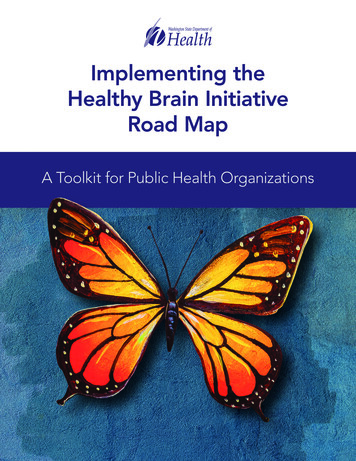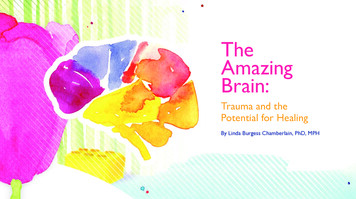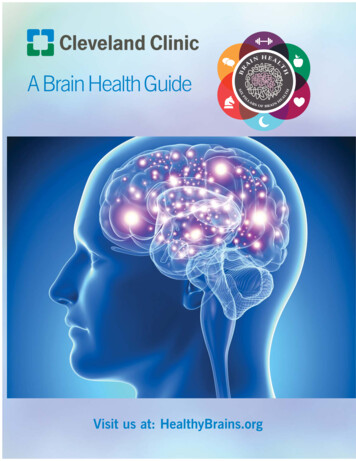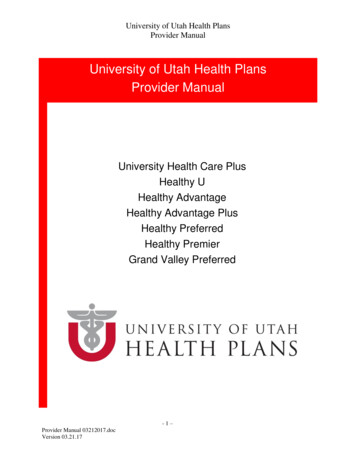
Transcription
Implementing theHealthy Brain InitiativeRoad MapA Toolkit for Public Health Organizations
ContentsBackground on the Healthy Brain Initiative. 3The Healthy Brain Initiative Road Map .3DOH: An Example of Integrating HBI .4Toolkit for Integrating HBI Into Your Organization.6How to Use This Toolkit .6Step 1 Make a Case to Agency Leadership.7Document 1.1Document 1.2Document 1.3Document 1.4Documenting the Need for HBI-Integrated Work Example.8HBI Road Map Executive Summary. 10HBI Road Map for Indian Country Executive Summary. 1210 Ways to Love Your Brain. 14Step 2 Designate Roles and Identify Possible Workgroup Members . 15Document 2.1 Workgroup Members. 16Step 3 Recruit Workgroup Members. 17Document 3.1 Example Email to Recruit Workgroup Members. 18Step 4 Plan and Hold Meetings. 19Document 4.1 Pre-Meeting Assignment Descriptions. 23Document 4.2Document 4.3Document 4.4Document 4.5Email Invitation to Meeting 1. 24Pre-Meeting 1 Assignment. 25Meeting 1 Agenda. 26Post-Meeting 1 Survey. 27Document 4.6 Pre-Meeting 2 Assignment. 28Document 4.7 DOH’s Draft of the Healthy Aging Work Document. 29Document 4.8 Meeting 2 Agenda. 30Document 4.9 Other Agency’s Use of Healthy Brain Messaging. 31Document 4.10 Post-Meeting 2 Survey. 33Document 4.11 Meeting 3 Agenda. 34Document 4.12 DOH’s Final Healthy Aging Work Document. 35Document 4.13 Pre-Meeting 4 Assignment. 41Document 4.14 Meeting 4 Agenda. 42Document 4.15 What is Public Health? Infographic. 43Step 5 Present Findings to Agency Leadership. 45
Background on the Healthy Brain Initiative“Over the 20th century, public health playeda crucial role in adding years to life.In the 21st century, public health can playa crucial role in adding life to years.”—Trust for America’s HealthThe strength of public health comes from the abilityto combine science and community voices. Brainscience advancements made a significant difference inawareness and services provided to children and youth.We must leverage these advancements across the lifespan to strengthen how we support older adults andpeople with dementia.This is essential due to the serious and growing needsof people with dementia and all older adults. In 2021, an estimated 6.2 million Americans, age 65and older, are living with Alzheimer’s dementia. By2060, this number is projected to reach 13.8 million.1 In the United States in 2021 the total national costsfor caring for people living with Alzheimer’s and otherdementias is estimated to reach 355 billion.1 11 million Americans gave unpaid care to people withAlzheimer’s and other dementias.1 In 2020, this care equaled an estimated 15.3 billionhours of unpaid care, which has the economic value ofmore than 257.7 billion.1These facts show public health needs to take action tosupport individuals and networks affected by dementia.Public health agencies can deepen their support byintegrating the growing body of science on aging andour brains, creating a consistent message across allages, emphasizing that actions that are good for braindevelopment in early life are also protective againstcognitive decline and dementia in later life. The HealthyBrain (HBI) Initiative Road Map2 provides a model forbeginning that work. From this point forward we aregoing to reference the Executive Summary for theHealthy Brain Initiative Road Map, 2018–2023, as it isa condensed version of the longer HBI Road Map. Tohave a working understanding of the HBI framework wesuggest you read through the longer version first.The Healthy Brain Initiative Road MapThe HBI Road Map is a document designed by theAlzheimer’s Association and the Centers for DiseaseControl and Prevention (CDC). It provides 25 actions forpublic health agencies and their partners to target theirwork on brain health, provide better care for peoplewith cognitive impairment, and increase attentionto caregivers.The 25 actions are divided into four areas: Educate and empower Develop policies and mobilize partnerships Assure a competent workforce Monitor and evaluate progress.By using this document, organizations can effectivelyincorporate key steps to support people living withdementia and their loved ones. These actions aredesigned to be used by both local and state entities.1 es.pdf (pages 19, 27, 36, 57)2 oad-map-2018-2023.pdfImplementing the Healthy Brain Initiative Road Map Background on the Healthy Brain Initiative3
DOH: An Example of Integrating HBIIn 2018, the Washington State Department of Health(DOH) created a "Healthy Aging Workgroup." Theoverarching goal of this workgroup was to conduct andan internal assessment of "touch points" regardingaging work conducted throughout DOH and toidentify opportunities to incorporate the action itemsincluded in the HBI Road Map. DOH used the HBIRoad Map to structure their workgroup and find areasto continue developing interventions for healthy agingand healthy brains across our agency. The primary aimof this approach was to integrate aging into programsthroughout DOH. This toolkit will map out DOH’sprocess and demonstrate how other state or localpublic health agencies can use a similar approach toimplement the HBI in their organization.The Life Course PerspectiveTo implement the ideas behind the HBI, DOH useda "Life Course Perspective" to identify modificationsto messages that would help people understand howhealth behaviors and environmental conditions affectpeople now and as they age.The Life Course Perspective framework acknowledgeshealth development is a dynamic process that beginsbefore conception and continues through the lifespan.One’s current health status is based on cumulativeexperiences in one’s life and environments. Thisperspective is essential when considering the impact ofsystemic discrimination, access to housing, education,pollution, health care, and employment. Below is avisual to demonstrate this framework:One example of implementing the Life CoursePerspective within the HBI comes from DOH’sPrevention and Community Health Divisionworking on chronic disease prevention. Throughtheir participation in the DOH Healthy AgingWorkgroup, they adjusted messaging to pregnantand parenting teens and childcare providers toinclude how exercising and avoiding smoking canbe a protective factor against later life dementiafor both parent and child. Including similar brainhealth messaging to all people can empowerpeople as they age.Work‑life balanceThe Life Course Perspective1 High social status,positive parenting Access to care Positive schoolenvironmentHeath Development Job insecurity–ObesogenicenvironmentLow social AdultOlder Adult1 Graphic concept adapted from Halfon, N., Larson, K., Lu, M., Tullis, E., & Russ, S. (2014). Lifecourse Health Development: Past, Present andFuture. Maternal and child health journal, 18(2), 344-365.Implementing the Healthy Brain Initiative Road Map Background on the Healthy Brain Initiative4
What Did DOH Do?At the time the workgroup was formed, DOH hadabout 1,800 staff working in five divisions. The agency’sprograms and services: Help prevent illness and injury Promote healthy places to live and work Provide information to help people make informedhealth decisions Ensure Washington state is prepared for emergencies.Accomplishing this requires strong collaborationwith many partners every day. Ultimately, 33 peopleacross five divisions joined the DOH Healthy AgingWorkgroup. This work was led by two staff membersat DOH: Janna Bardi, Chief of Public Health Practiceand Marci Getz, Director of Healthy Aging Initiatives.Alisa Tirado Strayer MSW/MPH pulled all theinformation together into this toolkit. Time for planningand facilitating the work group was allotted into theirjob responsibilities. The process took approximatelyone year, including some disruptions due to COVID-19,as they integrated the role of group facilitators of theworkgroup into their daily job responsibilities, ultimatelyusing between one quarter to one half of their time.The overall steps of the process for DOH were:1. Made a case to our Agency Leadership Teamand received approval to create a Healthy AgingWorkgroup to conduct an internal assessmentof the touch points regarding aging work beingconducted at DOH.2. Recruited members from across DOH for theworkgroup.3. Held three meetings for all workgroup members todiscuss how workgroup members would integratenew healthy aging opportunities into their work.4. After completion of pre-meeting assignments oneand two, group facilitators met with each workgroupmember to capture member’s reflections on theirwork and how it supports healthy aging.5. Collected and displayed findings for our AgencyLeadership Team, demonstrating what is beingdone and where workgroup members identifiedopportunities for expanding healthy brain workacross DOH.6. Held final wrap up meeting with all workgroupmembers to outline plan to integrate brain healthinto each division’s work. At this meeting, somemembers of the workgroup discussed forminga Community of Practice to continue addressingthese topics.While DOH’s process took about a year, you may havean adjusted approach to integrate the HBI into yourorganization based on staff time, resources, and size.This is an iterative process where you collect informationand ideas from people across your organizationthroughout the integration of the HBI Road Map.Examples of Integrating HBIFor your process, we strongly suggest a cross-agencyapproach to allow engagement from departmentswhere you may not expect a healthy aging perspectiveto be relevant. Below are examples of expected andless expected opportunities to integrate healthy brainmessaging identified by the DOH Healthy AgingWorkgroup.Expected opportunity linking to HBI area E2DOH’s Chronic Disease Prevention Programidentified an opportunity to adjust tobaccoprevention messaging to incorporate the benefits oftobacco cessation to brain health.Less Expected opportunity linking HBI areaW5 and W6DOH’s Disease Control and Health StatisticsProgram plans to add information about dementia/brain health to Hepatitis C virus supports forproviders via Project ECHO.Very unexpected opportunity linking toHBI area P5DOH’s Health Facilities Licensing departmentidentified an opportunity in the facility licensureapplication process (for hospitals, behavioralhealth, and residential treatment facilities) toengage applicants to establish services/policiesthat are supportive for people with dementia andtheir caregivers.Implementing the Healthy Brain Initiative Road Map Background on the Healthy Brain Initiative5
Toolkit for Integrating HBI Into Your OrganizationHow to Use This ToolkitWho Can Use This Toolkit?HBI is designed for public health agencies and other partners to use to improve education and action surroundingbrain health. However, there are no guidelines on who within these organizations should be involved. At DOH,implementing HBI meant inviting all divisions. Broad buy-in across the agency allowed for meaningful impact.Each division does work related directly to healthy aging and brain health when using the framework of LifeCourse Perspective.Why Use This Toolkit?Using this toolkit can provide: Support when seekingorganizational backing to start yourHealthy Aging Workgroup. A model to implement HBI intoyour organization. Increased action on brain health anddementia within your organization.Step-by-Step InstructionsThis toolkit provides step-by-step actions to walk your organizationthrough integrating HBI into your workflow.This toolkit provides: A planning guide for public health agencies to assess current workbeing done to promote healthy aging and to identify opportunities toimplement the 25 action items listed in the HBI. Checklists for each step. Appendices with examples of emails, documents, and resources tohelp your planning.Implementing the Healthy Brain Initiative Road Map Toolkit for Integrating HBI Into Your Organization6
STEP 1Make a Case to LeadershipYour goal for this step is to secure organizational support for using HBI in your workplace. You want youragency leadership to understand why this is important and how you will organize your workgroup. Beloware steps to help develop your proposal for your agency leadership.Checklist Gather/create presentation materials: Create a handout documenting the need forHBI‑integrated work and an overview of yourplan. (Document 1.1 on pages 8–9 is an exampleprepared by DOH.) HBI Road Map Executive Summary (SeeDocument 1.2 on pages 10–11 and Document 1.3for Indian Country on pages 12–13.) 10 Ways to Love Your Brain (See Document 1.4 onpage 14.) Presentation slides, if needed. Identify who will present to agency leadership: Identify your “ask” from agency leadership (e.g.,funding for the workgroup, identifying possibleworkgroup members, logistical support, etc.): Plan for post-meeting follow-up: Send a short meeting summary to agencyleadership with any documents they request. Develop a plan to check in with agency leadershipover the course of the workgroup and for apresentation to agency leadership once the workis completed.Learn. Plan.Respond to Dementia.Healthy Aging — Aligning and Increasing DOH’s EffortsCoordinating existing supports and services to avoidduplication of efforts, identify gaps, and increase accessto services and supports.Making Alzheimer’s Our NextPublic Health Success StoryConducting, communicating, and disseminating researchfindings and best practices to support healthy aging. Are communities ready to respond to a large populationof older people with dementia? Current projectionsComplementing and supplementing existing supportsindicate the number of people living with Alzheimer’s andand services, particularly in terms of integrating clinicalother dementias is ballooning as the Baby Boom generationand population health approaches.gets older. Those with dementia will require more and moreTrust for America’s Health strongly advocates for state support as cognitive, behavioral, and physical functioningworsens over time. This means Medicare and Medicaidhealth improvement plans to include a framework for howcosts are rising dramatically, and the additional burden onthe state public health system can address healthy aging.family caregivers is endangering their own health.With a strong response, public health can mitigatethe future impacts of Alzheimer’s and otherdementias, especially among vulnerable populations.The Alzheimer’s disease continuum spans decades,providing many opportunities to change outcomes acrosscommunities. Just as with other chronic and degenerativeUsing this framework, DOH staff have engaged in discussions with our partners about furtheringconditions, public health can reduce risk in populations,our Healthy Aging work. We propose DOH commit resources to fulfilling these actions:further early detection and diagnosis, improve safety andquality of care for people living with cognitive impairment,Stand up an internal Department of Health workgroupand attend to caregivers’ health and wellbeing.PROPOSALCommitting to Healthy Aging Work at DOH Conduct an internal inventory of touch points regarding Healthy Aging workDISPAfoorktWenetMonitorAssureaORSLE SECTLTIPMUMzePartThe number of older American Indians andAlaska Natives (AI/ANs) is increasing. Anestimated 569,000 AI/ANs are aged 65 orolder. This number is expected to triple overthe next three decades. The number of AI/ANs living with dementiais also expected to increase. Between 20142060, the number of AI/ANs aged 65 andolder living with dementia is projected togrow over five times. In 2015-2017, one in six AI/ANs aged 45and older reported subjective cognitivedecline (SCD), which are self-reporteddifficulties in thinking or remembering.Nearly two-thirds (63%) of those with SCDhad to give up some day-to-day activitiesbecause of these cognitive problems. 10 WAYS TO LOVE YOUR BRAINSTART NOW. It’s never too late or tooearly to incorporate healthy habits.With dementia, it’s not just the personwith cognitive challenges dealing with thecondition. Family members and friends feelthe impact too.HIT THE BOOKSWHAT IS DEMENTIA?Dementia is a chronic condition that affectsa person’s brain. People with dementia havea variety of cognitive problems with memory,thinking, communication, and carrying outeveryday tasks. Dementia gets worse over time,and people gradually lose their ability to take careof themselves. It can be difficult to provide care forpeople with dementia, especially when they needmany hours of care over multiple years.Formal education will helpreduce risk of cognitiveBREAKdecline and dementia.A SWEATTake a class at a localEngage in regularcollege, communitycardiovascular exercisecenter or online.that elevates heart rate andincreases blood flow. Studies havefound that physical activity reducesrisk of cognitive decline.Alzheimer’s is the leading cause of dementia.STUMPAlzheimer’s is a disease that damages anddestroys brain cells over time. Vascular dementia YOURSELFChallenge your mind. Build ais the second most common cause of dementia.piece of furniture. Play gamesVascular dementia is caused by conditions orlifestyle behaviors, such as smoking cigarettes or of strategy, like bridge.not being active, that weaken or block blood flow tothe brain.BUDDY UPBUTT OUTSmoking increases risk ofcognitive decline. QuittingFOLLOWsmoking can reduce riskto levels comparableYOUR HEARTto those who haveRisk factors fornot smoked.cardiovascular disease andstroke – obesity, high bloodpressure and diabetes – negativelyimpact your cognitive health.Growing evidenceDocument 1.3nerEduc ate&EmpHEADS UP!indicates that people canreduce their risk of cognitivedecline by adopting key lifestylehabits. When possible, combinethese habits to achieveBrain injury can raise risk ofcognitive decline and dementia.Wear a seat belt and use ahelmet when playing contactsports or riding a bike.maximum benefit for thebrain and body.SSROACslationans&iliSELECT FACTS Staying socially engagedmay support brain health. FindThe Alzheimer’s Association and Centers for Disease Control and Prevention also have a companion guide for state and localways to be part of your localpublic health officials: HBI State and Local Public Health Partnerships to Address Dementia: The 2018-2023 Road Map.community or share activitieswith friends and family.earch & Tresci eobRoad Map for Indian CountryAB&o liop PAccelerated progress against dementia requires stateand local public health leaders to chart a course forbetter outcomes. The HBI Road Map outlines the mostneeded and practical steps that state and local healthdepartments can accomplish. Implementation of the HBIRoad Map enables public health to lead with urgency andact for impact.ETIRID e ve lDocument 1.1Alignment of HBI Road Map actions with EssentialServices of Public Health ensures that initiatives to addressAlzheimer’s can be easily and efficiently incorporated intoexisting public health initiatives. Cross-sector partnerships,data, and pursuit of health equity are critical to achievingmajor gains against Alzheimer’s—just as they underlie publichealth successes in HIV/AIDS, cardiovascular disease,and cancer.Conceptual Framework for theThe impact of Alzheimer’s will only continue to grow.Healthy Brain Initiative Road AI/ANMap leaders can use the Road Map for Indian Countryto learn about Alzheimer’s, find out what some AI/ANcommunities are doing, plan their response, and start takingCO action throughout their own community.LLSrceEATateORaluEvOver the 20th century, public health played a crucial role in adding years to life.In the 21st century, public health can play a crucial role in adding life to years. Applied Rstrategically to prepare their communities by stimulatingneeded changes in policies, systems, and environments.To focus the public health response, experts developedan agenda of 25 actions for public health leaders toPossibly work toward the AARP Age-Friendly status for the Statepromote brain health, better care for people with cognitiveDetermine scope of collaboration with the Washington State Dementia Action Collaborative (DAC)impairment, and increase attention to caregivers.Other Road Map actions build public health capacity.Data sharing between DSHS–ALTSA, DOH and Public Health – Seattle & King County with aprimary goal of examining the data to identify health disparities in WashingtonELIMINATEHEALTHThe Healthy Brain Initiative’s (HBI) State and Local PublicEnhance Behavioral Risk Factor Surveillance System (BRFSS) data:Health Partnerships to Address Dementia, The 2018Advocate for DOH to include the Caregiver or Cognitive Decline modules into each BRFSS cycle2023 Road Map will chart a course for state and localpublic health agencies and their partners to act quickly andData analysis by DOH and DSHS Aging and Long-Term Support Administration (ALTSA)The impact of dementia is felt by multiple generations.People living with this chronic condition gradually needmore help caring for themselves including help managingmedications, bathing and feeding, paying bills and cleaning,or help going to appointments or social events. Familymembers, from the young to the old, play a vital role inproviding this care to relatives with dementia which cangrow more intense over time. But there are ways to lessenthis impact. More education about dementia and increasedsupport throughout the community can help both people withdementia and caregivers stay as healthy as possible. And,traditional wellness practices and public health efforts thatSELECT FACTScontrol high blood pressure and diabetes are ways to reducethe risk of dementia across generations.Today, nearly 6 million Americans are livingwith Alzheimer’s dementia, with annualWhat can tribal leaders and tribal health and agingcosts topping 277 billion. In 2050,professionals14do to promote wellness among elders,million will be affected, with an annualcost those affected by dementia? How can theyincludingto the U.S. of 1.1 trillion.support family care and prepare their communities for thefuture?African Americans, Hispanics, and womenare particularly at risk of developingThe Healthy Brain Initiative’s (HBI) Road Map for IndianAlzheimer’s and other dementias. Country is a guide for AI/AN leaders to learn about dementiaand start discussions throughout their communities. Theguide suggests eight strategies that embrace communityMore than 95% of people with dementiastrengths, including traditional practices, resilience, andhave one or more other chronic conditions.existing services. The strategies can be tailored to uniquepriorities of each community. Educational materials from theIn 2015, there were 1,471 emergencyAlzheimer’s Association, the Centers for Disease Controldepartment visits for every 1,000 Medicareand Prevention, and others can make it easy to get started.beneficiaries with dementia.Discover how to strengthen the well-being of older adultsAbout 1 in 3 Alzheimer’s caregiversandreportfamilies dealing with dementia and to protect futuretheir health has become worse duegenerations.to careGet the Road Map and find helpful tools at:responsibilities. cdc.gov/aging alz.org/publichealth/indiancountrynCollecting data to assess community health status(including inequities) and aging population needs toinform the development of interventions.ati othe wider community.Connecting and convening multiple sectors andprofessions that provide the supports, services, andinfrastructure to promote healthy aging.eNFacilitating socialengagement.Healthy aging focuses onmaximizing physical, mental,emotional, and social wellbeing, while recognizing thataging often is accompaniedby chronic illnesses andfunctional limitations. Healthyaging emphasizes the needfor meaningful involvement ofolder adults with others, suchas friends, family members,neighbors, organizations, andTrust for America’s Health’s framework for an Age-FriendlyPublic Health System includes these strategies:thOptimizing physical, cognitive,and mental health.How can Public Health help?erPromoting health, preventinginjury and managingchronic conditions.The population of older American Indians and AlaskaNatives (AI/ANs) is growing — and quickly. Between2014–2060, the number of AI/ANs aged 65 and older livingwith dementia is projected to grow over five times. Theselonger lives give more time for older generations to shareknowledge and traditions with the next. But greater agebrings increased risk for Alzheimer’s and other dementias —when memory and thinking problems interfere with daily lifeand activities.owHealthy aging is defined as:FRAMEWORKCompWhat is Healthy Aging?TAKE CAREOF YOURMENTAL HEALTHSome studies link depressionwith cognitive decline, soseek treatment if you havedepression, anxiety or stress.CATCHSOMEZZZ’SFUELUP RIGHTEat a balanced diet that ishigher in vegetables and fruitto help reduce the risk ofcognitive decline.Not getting enoughsleep may result inproblems with memoryand thinking.ship sLEVECTRAPAGERESOD IMURCES FOR SUSTAINEThe Action Agenda of the HBI Road Map aligns across fourEssential Services of Public Health. Each action was developedwith attention to three guiding core principles.The companion Healthy Brain Initiative: The Road Map for Indian Country is specifically designed for public health systemsserving American Indians and Alaska Natives.Document 1.2Implementing the Healthy Brain Initiative Road Map STEP 1 Make a Case to LeadershipVisit alz.org/10ways to learn more.Document 1.47
Document 1.1 Documenting the Need for HBI-Integrated Work ExampleHealthy Aging — Aligning and Increasing DOH’s EffortsWhat is Healthy Aging?Healthy aging is defined as:Promoting health, preventinginjury and managingchronic conditions.FRAMEWORKHow can Public Health help?Trust for America’s Health’s framework for an Age-FriendlyPublic Health System includes these strategies:Connecting and convening multiple sectors andprofessions that provide the supports, services, andinfrastructure to promote healthy aging.Optimizing physical,cognitive, and mental health.Facilitating socialengagement.Coordinating existing supports and services to avoidduplication of efforts, identify gaps, and increaseaccess to services and supports.Healthy aging focuses onmaximizing physical, mental,emotional, and social wellbeing, while recognizing thataging often is accompaniedby chronic illnesses andfunctional limitations. Healthyaging emphasizes the needfor meaningful involvement ofolder adults with others, suchas friends, family members,neighbors, organizations, andthe wider community.Collecting data to assess community health status(including inequities) and aging population needs toinform the development of interventions.Conducting, communicating, and disseminatingresearch findings and best practices to support healthyaging.Complementing and supplementing existing supportsand services, particularly in terms of integrating clinicaland population health approaches.Trust for America’s Health strongly advocates for statehealth improvement plans to include a framework for howthe state public health system can address healthy aging.PROPOSALCommitting to Healthy Aging Work at DOHUsing this framework, DOH staff have engaged in discussions with our partners about furtheringour Healthy Aging wor
Brain (HBI) Initiative Road Map2 provides a model for beginning that work. From this point forward we are going to reference the Executive Summary for the Healthy Brain Initiative Road Map, 2018–2023, as it is a condensed version of the longer HBI Road Map










